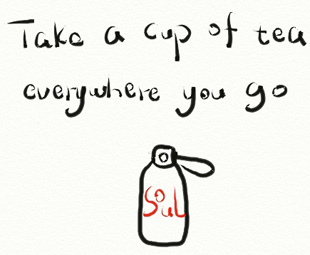
Over thousands of years trying and testing plants, the ancient Chinese found tea not just refreshing but an effective remedy as well. Widely used as medicine even then, tea is now recognized as a way of maintaining health and correcting mild complaints, such as sleeplessness, coughing or fatigue.
Tea is usually divided into six categories: green tea, black tea, dark tea, oolong tea, white tea and flower tea - each has its own properties for health.
Green tea
Green tea includes the famous Longjing from Hangzhou, the capital city of Zhejiang Province; Biluochun from Suzhou, Jiangsu Province; and Maofeng from Yellow Mountain in Anhui Province - it is a favorite for many Chinese.
Green tea is rich in vitamin C. It is now widely recognized as an antioxidant that can delay the aging process and help prevent cancer. But it can do much more than that.
Cold yin green tea can help improve the metabolic system for urination, it may dispel excessive internal heat and relieve indigestion and diarrhea. Green tea also helps people refresh themselves though black tea and coffee are the choice of most when they feel sleepy.
Black tea
Black tea which is popular in the West is fermented tea which is "warm." It can help relieve stomach pains.
Recent research shows that drinking black tea can also help prevent or relieve thickened arteries or veins that can cause strokes or heart disease. Crusted black tea can help relieve chronic respiratory diseases such as asthma.
The most well-known Chinese black teas come from Qimen in Anhui Province, which is called as Qihong. There are also popular Chinese black teas in the provinces of Yunnan, Jiangsu, Hunan, Sichuan and Guangdong.
Dark tea
Dark tea - typically Pu'er tea - is also a fermented tea. It is usually made into hard dry bricks to preserve it.
In the plateau areas where there is a lack of vegetables and fruits and coarse grains comprise much of the fare, black tea helps people maintain a balanced diet.
Pu'er is "warm" tea that can help relieve ailments in the stomach. Surprisingly it can also help decrease blood fat and blood pressure, prevent hardening of the arteries and help weight loss. Yunnan Province is the home of Pu'er.
Oolong tea
Most oolong tea is semi-fermented "neutral" tea but there are exceptions.
Tieguanyin from Anxi in Fujian Province is cold while Dahongpao from Wuyi and Foshou from Yongchun, both in Fujian, are neutral.
Crusted oolong tea is often used to relieve colds and indigestion. It also helps decrease blood fat, weight loss, and works as an anti-allergen. Foshou tea can help relieve diarrhea and prevent high blood pressure.
White tea
White tea, like its name, is white. It grows mostly in Fujian Province with some also found in Taiwan.
Most white tea is naturally withered. The most famous tea includes Baihaoyinzhen and Baimudan. Cold energy white tea helps dispel internal heat and toxins, especially in the summer.
Drink a cup of Baimudan and it will help protect you from sun stroke. And it also helps improve eye sight. Recent research suggests that white tea helps protect the hematopoietic system from radiation.
Flower tea
Flower teas have a variety of functions.
Lavender helps relieve sleeplessness; cedronella (lemon grass) helps digestion; the osmanthus flower helps nourish and maintain the vocal chords; rose, lily, honeysuckle and hibiscus all help with weight loss.
In China where monsoons dominate most areas, there are four distinct seasons - warm spring, hot summer, cool autumn and cold winter. Accordingly, different teas are recommended for the different seasons.
In spring, though the universe is reviving with everything blossoming, many people feel sleepy. Flower teas like lily tea can help dispel the pathogenic coldness, promote yang energy and relieve sleepiness.
Many people suffer excessive internal heat through the hot summers. Ulcers of the mouth and stomach are common. Green tea, which is good at dispelling internal heat, can effectively help relieve thirstiness, indigestion, dissolve phlegm and heal ulcers.
In cool and dry autumns, neutral oolong tea is recommended as it can help moisten the skin and throat and also dispel internal heat while not stimulating. It can help people adapt to the changing weather conditions.
Black tea is the choice for winter. The thing in winter is to keep warm and protect oneself from pathogenic coldness. The yang energy that keeps us warm decreases in cold weather. Drinking warm black tea helps nourish the remaining yang energy and thus help warm the body and improve the ability to fight coldness.
As TCM doctors always warn, you have to pick the medicine that suits your own constitution - this is also true with tea. For "hot" people who feel heat easily and those who smoke or drink, green tea and Tieguanyin are the best choice.
Neutral oolong, dark tea and warm black tea suit cold people who are prone to feel cold or get diarrhea. Experts usually suggest that elderly people should drink warm tea.
Though tea is usually good for the health, experts warn that strong tea may bring the opposite effect. Drinking a lot of strong tea may dilute gastric acids and cause indigestion. It might also aggravate congestion and increase blood pressure and put extra pressure on the heart.
For most adults, about 12 grams of tea a day taking about 3 to 4 grams each time is appropriate. After taking medicine do not drink for an hour. People suffering from insomnia should not drink tea at night.